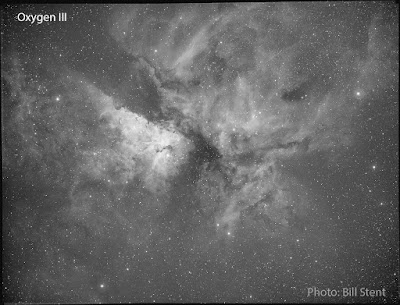Carina from home during lockdown
As you probably know, I do most of my astrophotography from the ASV's excellent dark sky site in Central Victoria. To make my narrowband images, I combine black and white photos taken using filters to make a full false-colour image.
But with the Coronavirus, the dark sky site has been closed. I have to take photos from my light-polluted back yard. To quote Edmund Blackadder, "needs must when the devil vomits in your breakfast".
Last Monday, the first half of the night was forecast to be clear, so I set up in the back yard and went for the Carina Nebula. This is a bright nebula and therefore less affected by light pollution.
After my setup routine, including polar aligning, focusing and framing up the nebula, I started getting images. My first batch was a stack with the Oxygen filter. Oxygen is naturally a blue colour, and I normally present it as blue in the final image. I've attached the Oxygen photo.

Next, I started on my Sulphur filter. I intended to map this to red. However, the clouds had different ideas, and cut my imaging session short. What I got was OK, and you can see it here.

Because I had two images, it was enough to make a sort-of-a-colour image, which I've attached. Oxygen went to blue and Sulphur went to both green and red.

I thought this was – meh – good enough for a back-yard effort, but then I remembered that I had some Hydrogen data from last year. I've attached it as well. You can see that dark sky photos are always better.

So I was able to get a false-colour image after all. I'm calling it Frankenphoto.
See how the photos don't quite match up? I normally crop this out, but I thought I'd leave it in to show. If you look at the three components, you can see the area right in the middle is mostly Hydrogen. It's much darker in the the Oxygen and Sulphur photos. It might also be bad calibration, of course. Finally, Astro Pixel Processor was clever enough to turn the Hydrogen photo upside-down before integrating it.
It's good enough.

Comments
Post a Comment